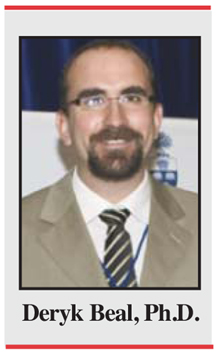By Deryk S. Beal, Ph.D., R.SLP, S-LP(C), CCC-SLP, Institute for Stuttering Treatment and Research (ISTAR), University of Alberta
 I recently spent 2 years studying brain development, motor learning, computational neuroscience and stuttering in Boston, Massachusetts. I am Canadian, and I also happen to be an intense hockey fan, and the team that I cheer for is the Boston Bruins. The Bruins take as their logo a large ‘B’ at the center of a circle with spokes radiating out from it. The significance of this symbol is that Boston is the economic and cultural ‘hub’ of New England; the metropolis where all people and things intersect. For me, the logo is analogous to the future state of knowledge discovery in developmental stuttering.
I recently spent 2 years studying brain development, motor learning, computational neuroscience and stuttering in Boston, Massachusetts. I am Canadian, and I also happen to be an intense hockey fan, and the team that I cheer for is the Boston Bruins. The Bruins take as their logo a large ‘B’ at the center of a circle with spokes radiating out from it. The significance of this symbol is that Boston is the economic and cultural ‘hub’ of New England; the metropolis where all people and things intersect. For me, the logo is analogous to the future state of knowledge discovery in developmental stuttering. For many years now, individual researchers have explored the separate spokes of the stuttering problem in relative isolation as compared to the interdisciplinary team approach afforded other health problems. Around the world, different labs have focused on the genetics underlying the disorder, or its neural correlates, or the psychoeducational characteristics of people with the disorder, or the impact of various types of pharmaceutical and behavioral treatment protocols on the speech and cognitive aspects that define stuttering. The achievements in each line of research have ranged from small to large and all have set the stage for an as-yet-to-come groundbreaking and paradigm shifting discovery in the overall field of stuttering research. Such a discovery will come about with the force of simply one word, namely, “convergence.”
My research career will be defined by convergence. The disorder, stuttering, will lie at the center of a multi-pronged approach to its understanding. To date my research program has utilized neuroimaging tools such as structural and functional magnetic resonance imaging and magnetoencephalography to understand how the brain differs in children and adults who stutter as compared to their fluent speaking peers. The results of my work to date indicate that from as early as 7 years old, the development of some of the brain regions crucial for learning the efficient planning and control of speech sounds are abnormal in people who stutter. These findings are interesting in and of themselves but their true impact will only be realized within the context of the other realms of research.
Ideally, future research will aim to collect multiple forms of data from a large and diverse group of people who stutter and utilize the expertise of clinicians and scientists from various fields. Such a dataset might consist of epithelial cells from a cheek swab for genetic analysis, structural and functional MRI images for brain development analysis, speech motor learning and cognitive affective profiles for behavioral analysis as well as treatment outcomes data. A dataset such as this would afford us the opportunity to understand the spatial profiles of genetic expression in the human brain, how the various regions of the brain network together differently to produce stuttered speech, as well as which of the genetic and neurological variables contribute to speech motor learning and therapeutic outcomes.
The collection and analysis of a large dataset such as the one proposed above is accompanied by numerous challenges. First, clinics that provide comprehensive and intensive treatment programs need to collaborate across the continent and the world over to ensure that sufficient numbers of volunteers are recruited.
Second, clinicians and scientists from varied backgrounds need to work together as an interdisciplinary team. Third, a framework is needed to organize the results. Computational network models of the brain could be leveraged in this regard. The hypothesized contribution of each brain region to the neural network for speech production would be referenced with respect to the spatial maps derived from structural and functional MRI and genetic expression studies. Based on these hypotheses we could potentially target pharmaceutical or neurostimulation strategies, such as transcranial magnetic stimulation or direct current stimulation, to the associated brain regions for the purpose of enhancing behavioral treatments. Of course, a time when these approaches might be a part of one’s everyday clinical experience is far on the horizon but the possibilities must be explored.
In summary, I believe that the best chance for a major leap forward in the field of stuttering research is the funding of larger projects with a focus on the convergence of multiple sciences. The institutions best positioned to lead this movement are those that already provide intensive and comprehensive treatment programs to relatively large populations of people who stutter. The future of stuttering research lies in the hands of the professionals who lead these organizations, our ability to work together as a consortium and in the equal partnership that we forge with the people we serve, people who stutter.
Do you agree? Disagree? Give us your feedback. Email us at info@StutteringHelp.org.
From the Winter 2013 Newsletter






 Podcast
Podcast Sign Up
Sign Up Virtual Learning
Virtual Learning Online CEUs
Online CEUs Streaming Video Library
Streaming Video Library